
Heading Into 2021: Technological Advancements in Solar
As we approach the end of 2020, solar remains in a state of constant innovation. Technological advances continue to improve as we find new ways to increase the conversion of light to electricity. Today, you can build a system with less panels, less labour, less wiring, and in a smaller footprint than you could a few years ago, opening the doors for a multitude of new users and utility-scale projects.
Innovations in solar cells, modules, and wafers will continue to increase power output without proportionally increasing the manufacturing costs, resulting in lower dollar-per-watt module cost and balance-of-system (BOS) cost savings.As system costs continue to come down, more users can afford to adopt solar into their energy plan. More adoption leads to more incentive for manufacturers to innovate, which in turn leads to even greater efficiencies and further reduction in costs.
This article explores some of these recent technological advances and breakthroughs that have enabled solar cost to come down through increased efficiency and power output. So what are some of these technological advancements?
Improved Wattage and Efficiency
While solar panels can range in wattage, today a typical panel produces around 320 watts of power compared to an average of 200 watts in 2012 (and a mere 20 watts in 1954). This is a massive improvement, nearly doubling in power over the past 8 years alone. In fact, just this past summer a number of solar panel manufacturers announced new models surpassing 500 W. The most popular solar panels for residential customers in 2020 includes panels rated to produce anywhere from 285 watts to 360 watts [1].
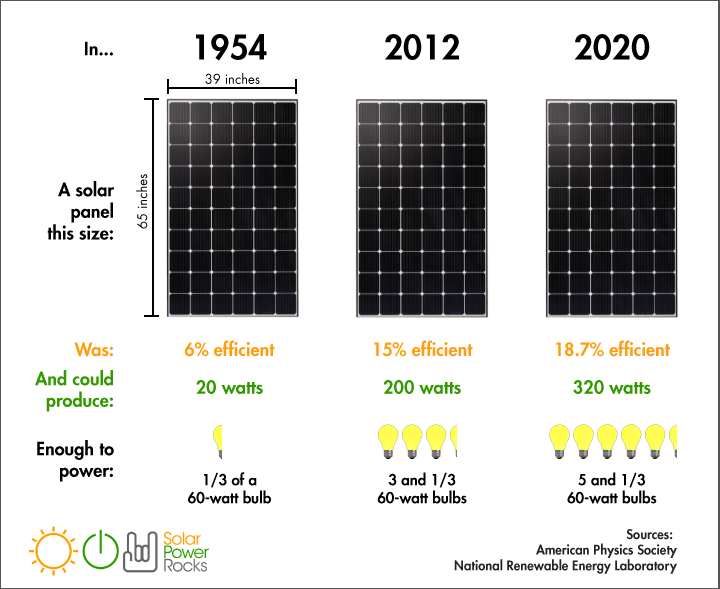
Solar panel efficiency 1954, 2012, and today [www.solarpowerrocks.com]
Solar efficiency relates to the amount of available energy from the sun that gets converted into electricity. As of 2020, the efficiency of the most advanced solar cells is closer to 25%, while average solar cells for residential use are around 19% efficient.
While higher-wattage panels are great for certain applications, because they are more expensive, they’re usually only needed if you have limited space on your roof. If you have the space, it often makes more sense to use cheaper panels in greater numbers. Your solar consultant will work with you to figure out how many panels you need to produce enough energy for your usage.
Half-Cut Cells
A Solar Panel with Half-Cut cells is just a normal solar cells that have been cut in half. Why would you want to do this? While a typical solar panel has 60 or 72 solar cells, panels with half-cut cells have 120 or 144 half sized cells while maintaining the same dimensions. The result is a lower electrical resistance that improves the efficiency of the panel.
A half-cut cell will produce half as much current and one-fourth as much resistance. However, there’s twice as many cells meaning that, compared to a standard panel, the current is the same but with half the resistance. This lower resistance reduces electrical losses and improves panel efficiency.
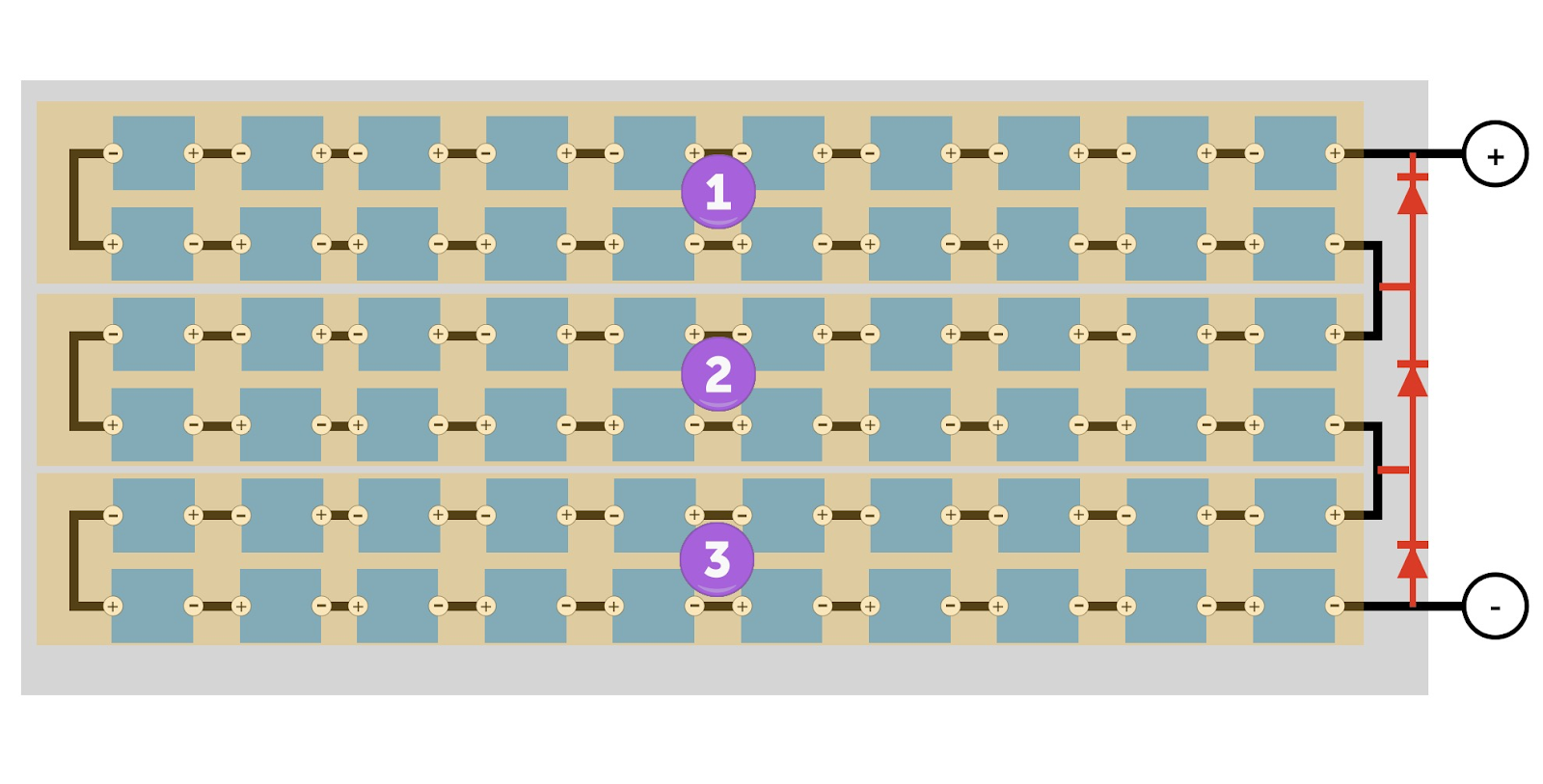
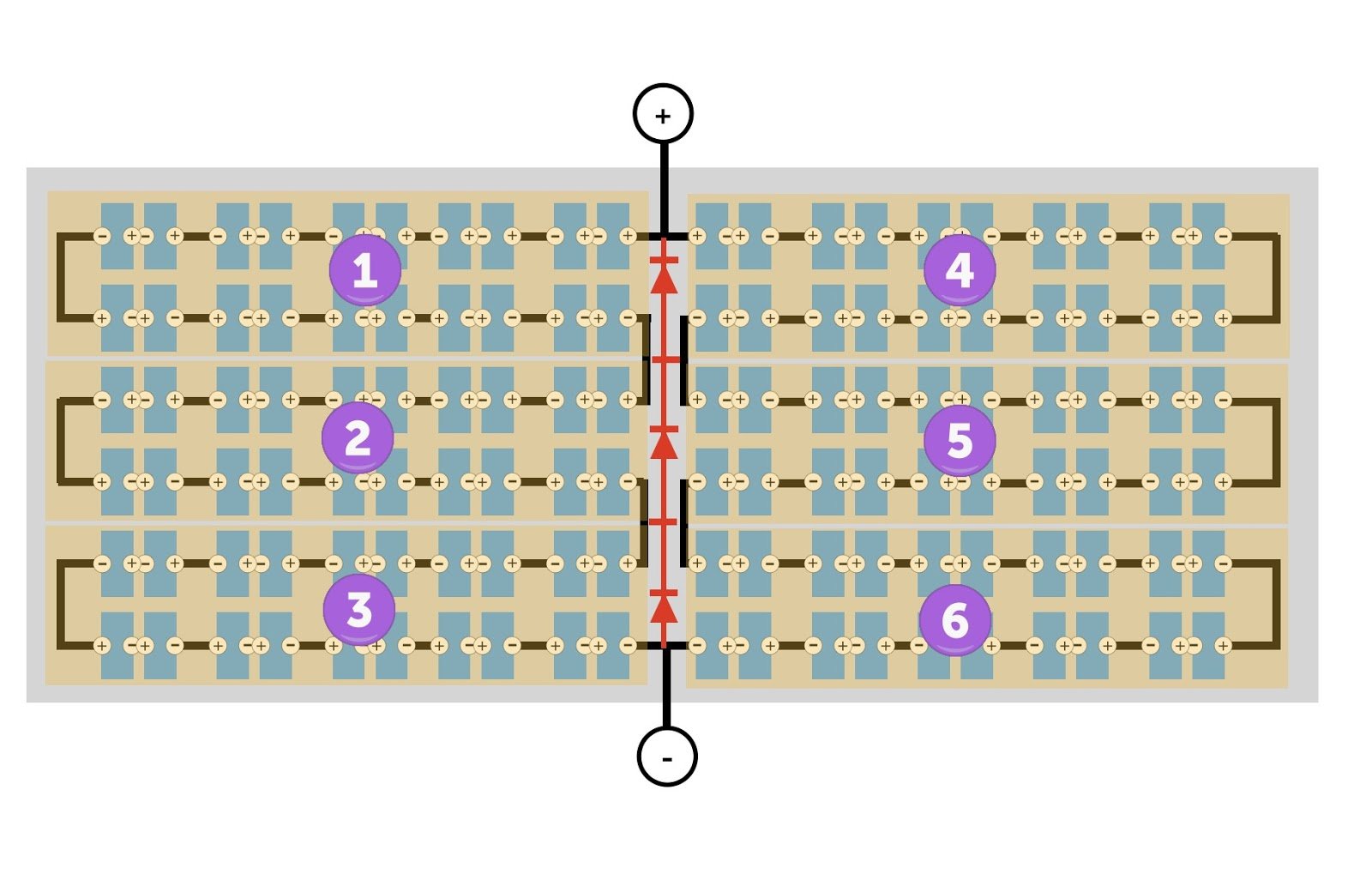
Wiring scheme for a traditional solar panel vs a solar panel made with half-cut cells. There are six separate “rows” of cells wired together in parallel [Source]
An additional benefit is half cut panels resist the effects of shade better than standard solar panels. This is due to the way cells are wired together: “bypass diodes restrict the loss of power from the shaded portion instead of the entire panel. It creates a substitute path for the current to travel in the unshaded part and avoids the current to pass through the shaded part. It reduces the effect of shading and increases its performance in partial shadow conditions.” [2]

Several large manufacturers are convinced modern production techniques make half cut solar cell panels worthwhile and as per the technology roadmap of PV, and twin cell solar market share is expected to increase from 18% in 2018 to 40% by 2028.[3]
Larger Silicon Wafers
Some of the increased power output of solar panels discussed earlier in this article is attributed to a shift to larger crystalline silicon wafers. A silicon wafer is a thin slice of a crystalline silicon (semiconductor) used for fabricating integrated circuits in photovoltaics to manufacture solar cells. Large wafers allow modules to have more space for photoelectric reactions, increasing the electricity generation per panel while reducing the need for wires, junction boxes and other components that can raise Balance of System costs.
The bigger the wafer, the more power it can generate because of its larger surface area. Making wafers as big as possible would seem like the obvious path to take, but industry-adopted standard panel sizes add constraints. While the panels with newer, larger silicon wafers may only weigh a little more than their smaller-wafer equivalent, these larger modules can exceed the weight limit for one-person installation. And large-format modules may prevent multiple rows from fitting on a small pitched roof. Using big-wafer modules in residential applications can take a little bit of extra planning.[5]
In the early 2000s, solar wafers were small, around 125mm in length. By 2012, the dominant wafer size was around 156mm. The last few years have seen increased interest in even larger wafers with M6 (166 mm), M10 (182 mm) and G12/M12 (210 mm).[6]
Only time will tell if the industry embraces the additional power output of larger silicon wafers, and a new standard is developed or if we stick to the current panel sizing. As with anything, talk to a consultant before starting your project to see what panels work best for your intended needs.
Bifacial Solar Panels
A Bifacial Solar PV is a solar module that can absorb light from both sides of the panel. Where traditional “monofacial” panels have a solid, opaque cover on one side, bifacial modules expose both the front and backside of the solar cells.
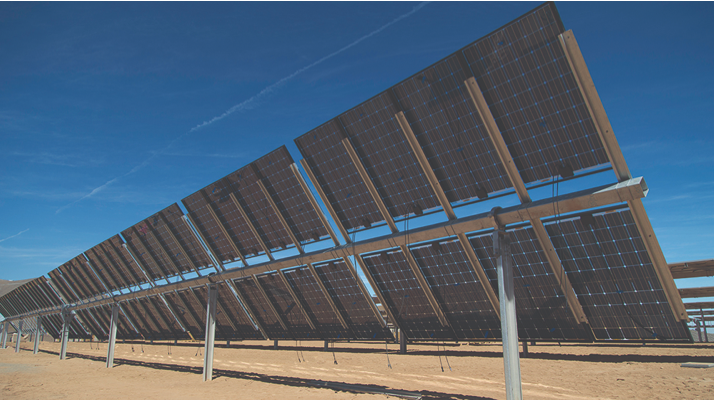
In the right circumstances, a bifacial solar panel has the ability to generate much more than a traditional solar panel. This is because they benefit from reflected light, diffuse light and albedo irradiance, in addition to direct sunlight on the face of the module.
A bifacial solar module can provide a 5 to 15 percent bonus in power output with only a 2 to 3 percent price premium. Since fewer modules are needed to produce the same amount of electricity, bifacial modules could reduce BOS cost by 3 to 7 percent. In fact, a recent study conducted by Joule shows that bifacial-1T installations (meaning a bifacial solar array mounted on a single-axis tracker) increase energy yield by 35% and reach the lowest levelized cost of electricity (LCOE) for the majority of the world (93.1% of the land area).[8]
If you’d like to learn more about Bifacial Solar Panels, you can check out our article: Bifacial Solar Panels Offer Lowest Levelized Cost of Energy for Solar
What do these technological advances mean for me?
Solar is in an exciting time. Technical advances are made every day, meaning falling costs (you can read about The Falling Cost of Solar here), and mass adoption. Furthermore, solar has received substantial government support allowing greater R&D.
While solar has been around since the 1950s, many of the greatest advancements have happened in the last 10 years alone. In that time period we’ve essentially doubled the power output of a solar panel while cutting the cost in half. As a result of these advances, solar was just named the cheapest electricity in history according to IEA. [7]
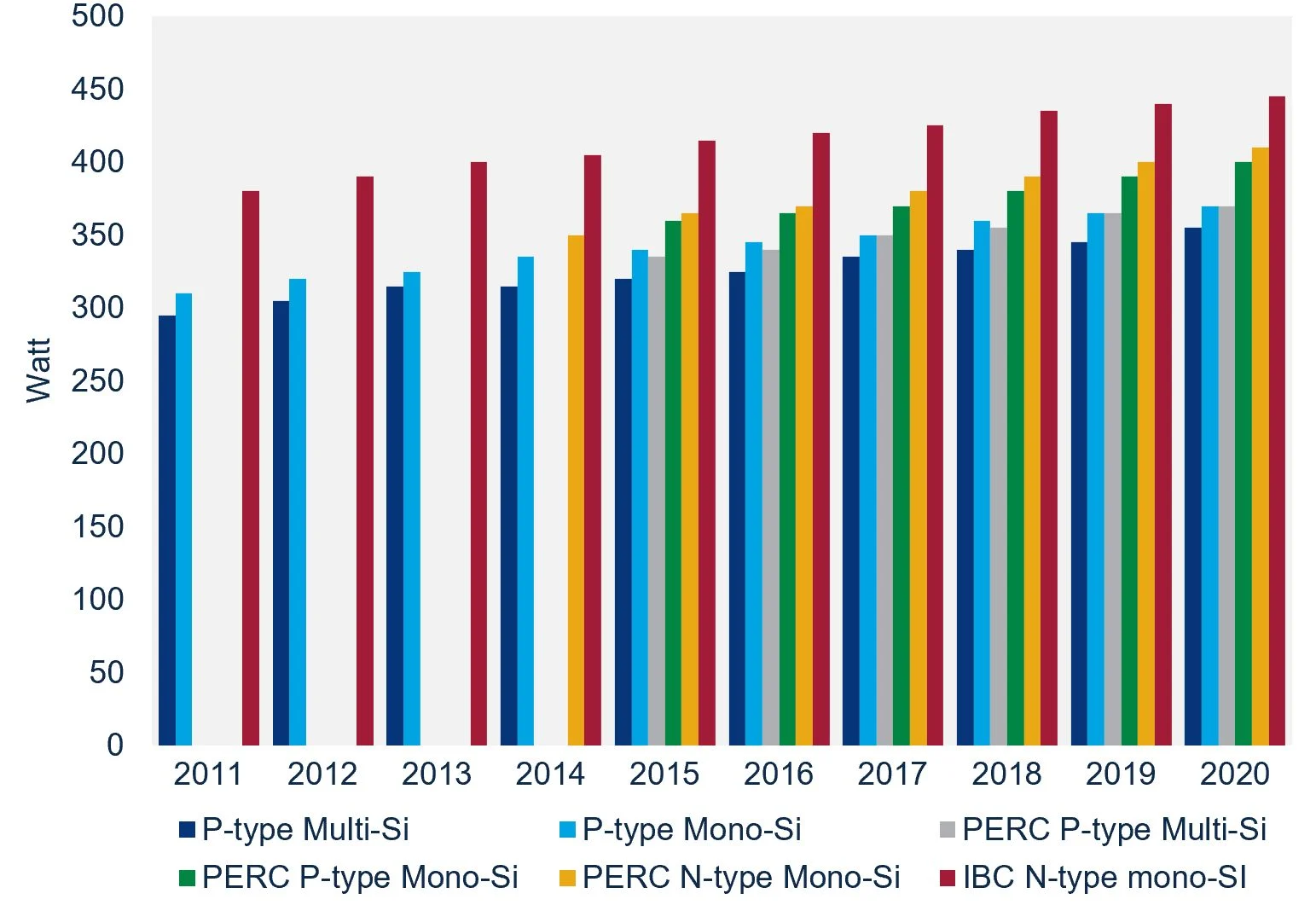
Solar Module Output by Technology [Source: GreenTechMedia]
Of course, these technological advancements offer many benefits to solar users:
- Levelized cost of energy decreases – if you look at the cost of the system over its lifetime, in most cases it’s cheaper than alternative non-renewable energy sources.
- Capital Costs Decrease – Even if the system pays for itself over time, lower capital costs means a lower barrier-of-entry for solar adoption.
- Ongoing Costs Decrease – Better tech means less maintenance, and more predictable behaviour from your system, meaning less money required to keep the system operating.
It is now safe to say that solar has entered its prime. If you want to know what the business case would be for your you, contact us today and see how much you could be saving on electricity.
{{cta(’96bae260-ddf8-4c9b-a2b7-eb26a259c8ff’,’justifycenter’)}}
Stay Up-To-Date With the Compass Newsletter
Join the Compass Newsletter to stay up-to-date with the latest renewable energy news, regulatory updates, and resources designed to help navigate your renewable energy journey
{{cta(‘d4c05dc8-bdba-44c5-af64-07fe8bf2eab3’)}}
It’s our goal to advance the role of clean energy in North America by providing expert and nuanced advice to decision makers and offering a range of engineering services. Because renewable Energy is a long-term investment, we want to ensure you have all the information and resources you need to make informed decisions that drive the success of your project.
-
Ben Zientara (2020, April 02). How much electricity does a solar panel produce? Retrieved October 15, 2020, from https://www.solarpowerrocks.com/solar-basics/how-much-electricity-does-a-solar-panel-produce/
-
Marsh, J. (2020, April 30). Half-cut Solar Cells: What You Need to Know: EnergySage. Retrieved October 15, 2020, from https://news.energysage.com/half-cut-solar-cells-overview/
-
Advantages of Half-cut cells. (2020, April 12). Retrieved October 15, 2020, from https://www.ecosoch.com/half-cut-cells/
-
Get 3 Solar Quotes From Your Best Local Installers. (2020, July 10). Retrieved October 15, 2020, from https://www.solarquotes.com.au/
-
Solar Wafer. (2019, September 16). Retrieved October 15, 2020, from https://solarfeeds.com/wiki/solar-wafer/
- Pickerel, K. (2020, September 24). Big-wafer solar panels aren’t quite ready for their residential debut. Retrieved October 15, 2020, from https://www.solarpowerworldonline.com/2020/08/big-wafer-solar-panels-arent-quite-ready-for-their-residential-debut/
-
Solar is now ‘cheapest electricity in history’, confirms IEA. (2020, October 13). Retrieved October 15, 2020, from https://www.carbonbrief.org/solar-is-now-cheapest-electricity-in-history-confirms-iea
- Rodriguez-Gallegos et al., Global Techno-Economic Performance of Bifacial and Tracking Photovoltaic Systems, Joule (2020), https://doi.org/10.1016/j.joule.2020.05.005
-
Sun, X. (2019, December 17). Solar Technology Got Cheaper and Better in the 2010s. Now What? Retrieved October 15, 2020, from https://www.greentechmedia.com/articles/read/solar-pv-has-become-cheaper-and-better-in-the-2010s-now-what
